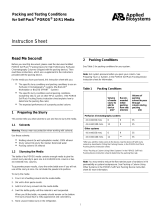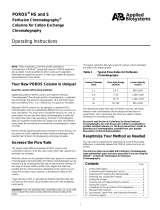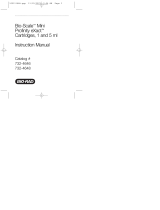Page is loading ...

Instruction Sheet
1
Read Me Before You Read the
Packing Device Document!
Use this instruction sheet in conjunction with the document titled
POROS Self Pack Packing Device for High Performance Perfusion
Chromatography Columns (shipped with the packing device).
Note: Section 2 of this instruction sheet replaces Section 4.3 of the
POROS Self Pack Packing Device instruction sheet.
Begin by reading the POROS Self Pack Packing Device instruction
sheet. When you reach Section 4.3, switch to Section 2 of this
instruction sheet.
Instructions at the end of Section 2 direct you back to the appropriate
section of the POROS Self Pack Packing Device instruction sheet.
Contents of this Instruction Sheet
For the media you have purchased, this instruction sheet tells you:
•The specific slurry conditions, packing conditions, and packing
instructions for Perfusion Chromatography® systems
(VISION™ or BioCAD® Workstation or BioCAD® SPRINT™
System) or FPLC® systems.
•The specific slurry conditions, all packing conditions except
flow rate, and packing instructions for other HPLC systems.
•The expected performance of a properly packed column.
1 Preparing the Slurry
Note: POROS 20 HE media is packaged in slurry form, using
20% ethanol as a preservative. This slurry is not ready for use in the
packing device. You must prepare the slurry before using it in the
packing device.
This section tells you what solvents to use and how to slurry the media.
1.1 Solvents
Warning: Always wear eye protection when working with solvents.
Use these solvents:
•Slurry solvent (to slurry the media): 0.5M NaCl
•Packing solvent: 0.1M NaCl
1.2 Slurrying the Media
The bottle of POROS media slurry contains enough slurry, when
prepared, to pack the following number of columns:
Table 1 Number of Columns
To prepare the media:
1. Swirl the media bottle gently until the beads are well suspended.
2. Pour the required amount of slurry into a scintered glass funnel:
•For a 4.6 mmD/50 mmL column: 3 ml
•For a 4.6 mmD/100 mmL column: 6 ml
3. Store any slurry remaining in the original media bottle
at 4°C.
4. Wash the media in the scintered glass funnel once with water to
remove the ethanol.
5. Wash the media three times with the new slurry solvent.
6. Resuspend the media into the required volume of new slurry
solvent:
•For a 4.6 mmD/50 mmL column: 6 ml
•For a 4.6 mmD/100 mmL column: 12 ml
Media Quantity
Number of Columns
4.6 mmD/50 mmL 4.6 mmD/100 mmL
(0.8 g) 2 1
(2.7 g) 6 3
Packing and Testing Conditions
for Self Pack® POROS® 20 HE Media

2
2 Packing Conditions
If you are packing a column using a Perfusion Chromatography system
or a conventional HPLC system, install a backpressure regulator on
your column. See Using the Backpressure Regulator, in the POROS
Self Pack Packing Device instruction sheet for information.
See Table 2 for packing conditions for your system.
Note: Set system pressure before you pack your column. See
Preparing Your LC System, in the POROS Self Pack Packing Device
instruction sheet for information.
.
*After you add this media slurry to the device, top the device off with slurry
solvent as described in Filling the Packing Device, in the POROS Self Pack
Packing Device instruction sheet.
**To keep within the pressure specifications of FPLC pumps, program your FPLC
system to deliver the flow rate with pump A and B (set “Conc % B” to 50 and
prime both pumps with packing solvent).
***See Packing a Column Using Other Systems in the POROS Self Pack Packing
Device instruction sheet to determine the packing flow rate.
Note: You may need to reduce the flow rate because of variations in frit
permeability or system backpressure. See Packing a Column Using
Other Systems in the POROS Self Pack Packing Device instruction
sheet for more information.
3 Packed Column Performance
This section describes:
•The maximum recommended flow rate for your packed column
•How to do a permeability test on your packed column
•The conditions necessary to run a protein separation test on
your packed column
You can verify your success each time you pack a fresh column and
monitor column performance over time. See Section 4.6, Testing the
Column, in the POROS Self Pack Packing Device instruction sheet for
information about periodic testing.
3.1 Recommended Maximum Flow Rate
The maximum recommended flow rate for the column during normal
operation is 85% of the packing flow rate. This flow rate keeps the
pressure within the operating limit you recorded in Packing the
Column, in the POROS Self Pack Packing Device instruction sheet.
When you work with viscous solvents, lower the operating flow rate to
account for the greater pressures generated by the greater viscosity.
3.2 Permeability
Column pressure/flow characteristics are called column permeability.
Test column permeability at the recommended maximum flow rate to
establish a baseline.
To test column permeability:
1. Run 50 mM phosphate pH 7.0/0.15 M NaCl buffer through the
column at the recommended maximum flow rate.
2. Record the generated pressure (permeability baseline).
Whenever you re-test column permeability, do so under solvent and
flow rate conditions identical to those of this initial test.
3.3 Protein Separation
Before you run the protein separation test, equilibrate the column with
10 to 15 column volumes of buffer (see Table 3). Column bed volumes
are:
•For a 4.6 mmD/ 50 mmL column: 0.8 ml
•For a 4.6 mmD/100 mmL column: 1.66 ml
Then run the protein test standard under these conditions:
To prepare the protein test standard:
1. Create the test standard by dissolving 5 mg bovine serum albumin
and 5 mg lysozyme in 1 ml of buffer.
2. Filter the test standard using a 0.22 µ filter.
3. Store unused reconstituted test mix frozen.
Table 2 Packing Conditions
Volume
of media
slurry to
add to
device
(ml)*
Recom-
mended
initial
packing
flow rate
(ml/min)
Volume of
packing
solvent to pass
through
column during
packing
(ml)
Perfusion Chromatography systems
4.6 mmD/50 mmL 6 20 35
4.6 mmD/100 mmL 12 20 35
FPLC® systems**
4.6 mmD/50 mmL 6 10 35
4.6 mmD/100 mmL 12 10 35
Other systems
4.6 mmD/50 mmL 6 *** 35
4.6 mmD/100 mmL 12 *** 35 Table 3 Protocol
These conditions are common to all column sizes:
Eluent A 20 mM MES, pH 5.5
Eluent B 1 M NaCl in A
Flow rate 5 ml/min for FPLC system
10 ml/min for BioCAD Workstation
Sample 20 µl
Gradient 0–100% B in 10 column volumes
Detection 280 nm

3
3.4 Results
Compare your chromatogram with Figure 1 (generated on a
4.6 mmD/100 mmL column packed with a Perfusion Chromatography
system). To verify that your column is operating properly, confirm that
the two proteins on your chromatogram are separated and the peaks
are symmetrical. The areas of the two peaks may change according to
the purity of the proteins in your standard, but variation in area is not
important in measuring the resolving power of the column. Retention
times and bandspreading on your separation may be different but the
general profile should be similar.
If the general profile is not similar, make sure that your system is
functioning properly. If your system is functioning properly, unpack your
column and start again (see Unpacking a Column, in the POROS Self
Pack Packing Device instruction sheet).
Figure 1 A POROS 20 HE Chromatogram

Headquarters
850 Lincoln Centre Drive
Foster City, CA 94404 USA
Phone: +1 650.638.5800
Toll Free (In North America): +1 800.345.5224
Fax: +1 650.638.5884
Worldwide Sales and Support
Applied Biosystems vast distribution and
service network, composed of highly trained
support and applications personnel, reaches
into 150 countries on six continents. For sales
office locations and technical support, please
call our local office or refer to our web site at
www.appliedbiosystems.com.
www.appliedbiosystems.com
Applera Corporation is committed to providing
the world’s leading technology and information
for life scientists. Applera Corporation consists of
the Applied Biosystems and Celera Genomics
businesses.
Printed in the USA, 08/2001
Part Number 8-0147-40-1195 Rev. A
© Copyright 1997, 2001, Applied Biosystems. All rights reserved.
For Research Use Only. Not for use in diagnostic procedures.
Information in this document is subject to change without notice.
Applied Biosystems assumes no responsibility for any errors that may
appear in this document. This document is believed to be complete and
accurate at the time of publication. In no event shall Applied Biosystems
be liable for incidental, special, multiple, or consequential damages in
connection with or arising from the use of this document.
POROS products and perfusive chromatography are covered by U.S.
patents 5,552,041; 5,605,623; and 5,833,861; foreign patents pending.
Chromatography materials of certain pore geometries, including certain
wide-pore supports, can permit perfusive chromatography, that is,
separations in which the rate of intraparticle convection exceeds the
rate of intraparticle diffusion. Use of any such chromatography media at
sufficiently high linear velocity, without license, may constitute patent
infringement. A limited license to use the patented perfusive
chromatography process is granted with the purchase of POROS
products from Applied Biosystems. The license terminates upon
expiration of the useful life of the product.
Subtractive Assay technology, enabled by the use of ImmunoDetection
(ID) Sensor Cartridges and the INTEGRAL Micro-Analytical
Workstation, is covered by U.S. patent 5,234,586. Other patents
pending.
Applied Biosystems, BioCAD, ImmunoDetection, INTEGRAL, Perfusion
Chromatography, POROS, and Self Pack,are registered trademarks of
Applera Corporation or its subsidiaries in the U.S. and certain other
countries.
AB (Design), Applera, SPRINT, and VISION are trademarks of
Applera Corporation or its subsidiaries in the U.S. and certain other
countries.
FPLC is a registered trademark of Pharmacia LKB Biotechnology AB.
All other trademarks are the sole property of their respective owners.
/













